Portsmouth Corporation Tramways
History
In 1894, a number of civic luminaries began to agitate for the borough's horse tramways, which were owned by the Portsmouth Street Tramways Company and its parent, the Provincial Tramways Company, to be taken into municipal ownership, and to convert them to electric traction. Although the borough council commissioned a report, and seemed to be erring in favour of taking possession of the lines and leasing them back to the company, in September 1896 it decided not to proceed further.
Meanwhile, the PSTCo had applied for powers of its own to convert the horse tramways to electric traction, which whilst not opposed by the corporation, included various clauses protecting the latter's interests, including preservation of its right to compulsorily purchase the tramways — under the provisions of the Tramways Act, 1870 — 21 years after their enabling act(s), and at seven-year intervals thereafter.
By early 1897, the council had reconsidered its position, so wrote to the PSTCo asking it to name a price for the undertaking. The answer was, however, not to the council's liking, so it decided instead to wait for each of the lines to expire (under the 1870 Act), at which point it presumably expected to get each one at scrap prices. This would, however, take some time, as several of the lines had been built under acts which would not expire until 1901; additionally, it would not include the lines built under the Landport and Southsea Tramway Act, 1863, as that preceded the 1870 Act by seven years, nor the section of the PSTCo's Cosham line that lay outside the municipal boundary (i.e., beyond Hilsea). Instead, the council decided to apply for parliamentary powers to purchase the entire system, which, following agreement with the company, were unopposed; the powers were granted on the 12th August 1898 under the Portsmouth Corporation Tramways Act, 1898.
Notice was served on the PSTCo (as well as the PTCo, the owner of the Fratton lines) in December 1898, the date of the hand-over being mutually agreed as midnight on the 31st December 1899. Although a price had yet to be agreed, all seemed well until Christmas 1899, when the Tramways Committee announced that it would only buy the tramway, and that it was not interested in the omnibuses or the wedding/funeral services. Quite why the committee waited so late to make this announcement is unclear, though there are reasons to think that the company were playing games in the hope of extracting a better price and/or concessions; whatever the cause, the outcome was that the company's tramway manager refused to hand the tramway over when the council officers called to take possession on the last day of 1899.
Negotiations then proceeded behind closed doors, which was followed by a legal ruling in favour of the corporation, and an agreement that also gave the latter running rights over a portion of the PTCo's as yet unbuilt Portsdown and Horndean Light Railway, which would connect to the corporation's system at Cosham. The horse tramway system was duly handed over to the corporation at midnight on the 31st December 1900, the price having to be fixed by arbitration, as yet again agreement could not be reached, the company no doubt hoping for more money than the corporation had offered, but in the end getting less.
Meanwhile, the corporation had acquired powers for a further 4.5 miles tramway, which were passed into law as the Portsmouth Corporation Tramways Order, 1900, which was approved on the 6th August 1900 under the umbrella of the Tramways Orders Confirmation (No. 5) Act, 1900.
As soon as the corporation took possession of the tramways, it lost no time in starting construction, as the 1898 Act only allowed two years from the municipal takeover for the authorised lines to be completed. Construction commenced on the 23rd February 1901, horse-tram services being withdrawn as each line was reconstructed, then reinstated afterwards, until such time as sufficient electric tramcars were available (and motormen trained) to commence operation. The corporation probably intended to open its reconstructed system in one fell swoop, but was prevented from doing so by the slow delivery of electric tramcars. Despite these difficulties, the first day of electric operation dawned just seven months after reconstruction began — the 24th September 1901 — with circa 80% of the planned system complete, an impressive achievement by any standards.
The first lines were gradually joined by others over the course of the next few months, the initial tranche of lines being completed by the 11th December 1901. This just left the line out to Cosham, electric tramcars being prevented from reaching there by the Ports Bridge, which needed to be reconstructed. The Provincial Tramways Company's new electric tramway — the Portsdown and Horndean Light Railway — opened for business (from Cosham) on the 2nd March 1903, the corporation electric services finally reaching there just over one month later on the 18th April 1903. The last corporation-operated horse-tram services are reported to have been withdrawn (from the Cosham route) some time in May 1903.
The system was initially operated with 85 tramcars, with the first of 15 further vehicles arriving from December 1906.
Further tramway extensions were proposed, but nothing concrete happened until 1908, when a provisional order was submitted for a circa one mile extension along Goldsmith Avenue to Milton. This was apparently opened on the 20th July 1909, despite the relevant order (the Portsmouth Corporation Tramways Order, 1909) not being confirmed until the 20th September 1909, under the umbrella of the Tramways Orders Confirmation Act, 1909.
Powers for a further 1.9 miles of tramway were obtained under the Portsmouth Corporation Tramways Order, 1912, which was approved on the 7th August 1912, under the umbrella of the Tramways Orders Confirmation Act, 1912.
The new lines, along Twyford Road, Festing Road, and from Eastney to Milton, opened between the 4th July and the 22nd September 1913. These effectively took the 4ft 7¾ins-gauge tramway system to its maximum size of 17.7 miles. From the railway station, lines ran northwards to Kingston Cross (via Commercial Road and Kingston Crescent), with a branch northwards to Alexandra Park (along Twyford Avenue and Northern Parade); westwards to The Hard (via Park Road); southwestwards to Floating Bridge (via Cambridge Road and High Street); southwards to Clarence Pier (via Hampshire Terrace and Jubilee Terrace); and eastwards to Milton (via Blackfriars Road and Goldsmith Avenue). A long line also ran from Cosham in the north, via Kingston Cross and Fratton Road to Fratton, where the lines divided, both continuing southwards to Clarendon Road, one via Victoria Road and the other via Fawcett Road and Waverley Road. At Clarendon Road, these lines connected to a snaking east-west line from The Hard to South Parade (via Ordnance Road, St Georges Road, Alexandra Road, Kings Terrace, Jubilee Terrace, Southsea Terrace, Western Parade, Osborne Road, and Clarendon Road), which continued around to Albert Road (via St Helens Parade and Festing Road). The two Victoria Road and Fawcett Road lines were also intersected by another west-east line, which ran from Havelock Park to Milton (via Albert Road and Highland Road). In addition, there were a number of connecting lines, including one along Lake Road from Commercial Road to Fratton Road, as well as a branch line eastwards from Kingston Road, along New Road to Copnor.
PCT cars also ventured north over P&HLR tracks to the top of Portsdown Hill, but only between May 1903 to the 30th June 1907, and even during that period somewhat sporadically. Eventually, P&HLR cars were permitted to run through to central Portsmouth (and later Clarence Pier and South Parade), services commencing from the 1st August 1924 and continuing up until the P&HLR's demise in 1935.
Like many systems, Portsmouth was badly impacted by the Great War, chiefly through loss of men (and their skills) to the armed forces, over 70% of the pre-war workforce having joined up by 1917. There were also restrictions on new materials and spares, which together with the manpower issues, led to a reduction in service frequency, as well as a gradual deterioration in the condition of the tramcars and infrastructure. Despite post-war inflation, the corporation quickly set about putting its system in order, purchasing 12 new, totally enclosed tramcars in 1920. The corporation also took the decision to expand its service provision by taking delivery of 10 new motorbuses (in 1919), which it used to provide services to areas the tramways did not serve.
Powers for a new line from Milton to Hilsea were obtained on the 4th August 1920 under the Portsmouth Corporation Act, 1920, which also confirmed provisional powers for the corporation to run motorbuses within the borough. Whilst new rails were eventually obtained, and even moved into place along Copnor road ready for laying, the corporation suddenly decided against the new line, instead using the new rails to replace worn-out track elsewhere on the system.
Investment in the tramway system continued throughout the late 1920s and early 1930s, with a tram rebuilding programme commencing in 1929, and even as late as 1932, the complete relaying of the Ports Bridge to Cosham line on a new, reserved formation to one side of the road.
The corporation had, however, been toying with the idea of introducing trolleybuses, and on the 15th April 1930, it obtained powers to replace the existing tramway services with trolleybuses services. These powers were granted under the Portsmouth Corporation Act, 1930.
When the Fawcett Road tramway line came up for renewal, the corporation decided instead to remove the tracks, but leave the overhead wires in place in anticipation of a future trolleybus service. The last trams over this line ran on the 19th April 1931, being temporarily replaced by motorbuses. The Transport Committee took the decision to introduce a trolleybus service in late 1932, eventually procuring fifteen trolleybuses (in 1934), which it then used to operate a service between South Parade and Cosham, commencing on the 4th August. The success of the trolleybuses quickly led to a decision to withdraw tram services between North End and Cosham, the last regular PCT services over this section running on the 1st October 1934. This left the P&HLR as the sole tram operator north of North End, though it wasn't to last for long, the P&HLR closing just three months later on the 9th January 1935.
Although the corporation seems to have intended a gradual replacement of the tram services over 10 years, a decision was soon taken to accelerate this, and to expand the trolleybus network even further. Seventy-six new vehicles were ordered, the first arriving in 1935. The tramway services were gradually withdrawn, as and when sufficient trolleybuses became available, the last tram of all running on the 10th November 1936.
The PCT was a major municipal success, at least up until the early 1920s, the system being extremely well run and very profitable. This not only enabled a significant proportion of the loans to be paid off, but also the accrual of a substantial renewals fund, all whilst contributing significant sums to rates relief.
Uniforms
Following the corporation's take-over of the Portsmouth Street Tramways Company in 1901, the corporation operated horse trams for just over two years, the last one running in May 1903. Only a small number of photographs appear to have survived of the corporation horsecar services, and these suggest that the corporation merely continued the policy of the PSTCo, drivers and conductors wearing informal attire.
Electric tramcar crews appear to have initially worn informal attire too, possibly up until as late as 1902, though having said that, the photographic record for this period is extremely thin, with hardly any of the surviving images showing tramcar crews. At some point uniforms were issued; these comprised heavy-duty double-breasted jackets with three pockets, four pairs of buttons (probably brass — see link) and lapels. The left-hand collar bore system initials – ‘P C T’ – whilst the right-hand collar appears to have borne an employee number (both the initials and the numbers probably being brass to match the buttons). The tensioned-crown peaked caps bore a small shield-shaped badge taken from the city’s coat of arms; this was worn above a script-lettering grade badge, either 'Motorman' or 'Conductor', again more than likely in brass to match the buttons.
New dark grey uniforms — edged in red piping — were issued to all 355 staff in August 1916. These were very similar in style to their predecessors, being double-breasted with five pairs of buttons (four in later issues), three waist-level pockets, and lapels; the latter bore 'P.C.T' one-piece collar badges on each side rather than the individual metal letters and employee numbers that had been worn previously. The caps were unchanged, but now bore a prominent nickel and blue enamel cap badge; these were, however, not issued until the 27th September, possibly due to wartime supply difficulties. The new badges were emblazoned with the system title — ‘PORTSMOUTH TRAMWAYS’ — with an employee number in the centre; lower numbers were apparently issued to conductors and higher numbers to motormen (see 'Tramways of Portsmouth' by S E Harrison). The button material was possibly changed to nickel at this time, and in later years (i.e., the 1930s), to chrome.
At some point, probably in the 1920s, the 'P.C.T' collar badges were dispensed with in favour of the small municipal-device badge that had previously adorned the caps. Given that marked chrome 'tramway' buttons have survived in considerable numbers, it is probable that the municipal-device badges were also changed to chrome prior to closure.
Tramcar crews were also issued with long double-breasted greatcoats with five pairs of buttons, three waist-level pockets, high fold-over collars and epaulettes; the collars probably carried system initials up until the 1920s, thereafter the municipal-device badge. Tramcar crews also wore municipal licence badges, which appear to have been enamel; in addition to the number, they bore the crescent and star of Portsmouth. These badges were dispensed with around the time of the Great War, probably when the numbered cap badges were introduced.
It is unclear what uniforms were worn by inspectors, either during the early years of the tramway or towards the end of operation. Several examples of bullion-embroidered cloth badges have, however, survived for senior grades ('TIMEKEEPER', 'INSPECTOR', 'DEPOT INSPECTOR' and 'CHIEF INSPECTOR' are known), and it seems likely that these were worn on the jacket collars. Little is known about senior staff headwear, though some photographs suggest that the early caps may have been either of the kepi or drooping-peak type. A photograph taken late on in the tramways life clearly shows a senior uniformed member of staff wearing a tensioned-crown peaked cap, which if other systems are anything to go by, probably replaced the drooping-peak caps a good few decades earlier. These caps carried elaborate embroidered-cloth cap badges that probably bore the full system title in gold bullion (see below for an example). It is likely that the most senior grade, i.e., the Chief Inspector, wore a slightly more elaborate cap badge, but still of bullion-embroidered cloth.
In common with the majority of UK tramway systems, Portsmouth employed female staff during the Great War (from 1915 onwards) to replace male staff lost to the armed services; these ladies were overwhelmingly employed as conductresses, though a few were trained as motorwomen in 1918. It is unclear what uniforms were issued initially, though there is no reason to think that these were any different to those issued in August 1916, which comprised long tailored single-breasted jackets with five buttons, a waist belt with buttons, two waist-level pockets, high fold-over collars and epaulettes; the collars bore the same one-piece 'P.C.T' collar badges as the jackets worn by male employees. Two types of cap were worn, one probably for winter wear, and the other probably for summer. One type had a wide tensioned-crown made from woven straw (presumably for summer use), the other a baggy crown, a type that is usually referred to as a motor cap. The caps bore the same badges as those worn by male tramcar crews, i.e., a script-lettering 'Conductor' badge until September 1916, and the new nickel and blue enamel pattern from then onwards.
Portsmouth Corporation Tramways was officially renamed the ‘City of Portsmouth Passenger Transport Department’ on 14th July 1936, barely four months before the last tram ran. Whilst the ‘CofPPTD’ cap badge illustrated below could have been issued to tramway staff, it seems inherently unlikely given the short time span.
Further reading
For a history of the area's tramways, see 'Tramways of Portsmouth' by S E Harrison, Light Railway Transport League (1955).
Images
Horse tram drivers and conductors
Portsmouth Horsecar No 66 pictured at the corner of South Parade and St Helen's Park Crescent — photo undated, but given the lack of either the company's or the corporation's name on the side of the vehicle, very probably taken in 1901. My thanks to Martin Petch for help in identifying the location.
An enlargement of the above photograph showing the conductor. Although he is wearing a peaked cap, this was almost certainly self-purchased, as this had been a requirement of the tramway company (his previous employers). Photo courtesy of the National Tramway Museum.
Motormen and conductors
Two tramcar crews stand with Tramcar No 50 and its stable mate (to the left) – photo undated, but judging by the pristine condition of the vehicle, probably taken in 1902. Photo courtesy of the National Tramway Museum. 
An enlargement of the above photograph showing a motorman (left) and a conductor (right). Although both are wearing licence badges, there is no other sign that they are working for the corporation (i.e., uniforms, caps, badges etc.). This suggests that uniforms were not issued to electric tramcar staff for some considerable time.
Portsmouth Conductor 185 — photo undated, but very probably taken in the first decade of operation. Author's Collection.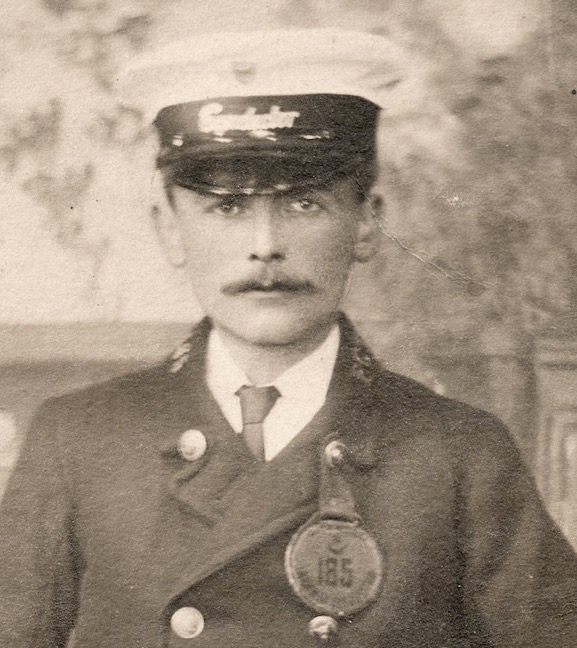
An enlargement of the above photograph showing details of the uniform, including the shield-shaped municipal-device cap badge worn on the rain cover, and the employee number on both the licence badge and the right-hand collar.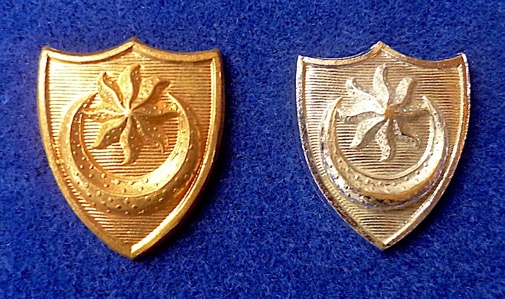
Portsmouth Corporation Tramways cap badges — brass/gilt and chrome. The brass badge was initially worn as a cap badge, but was later relegated to the collars following the introduction of the large cap badge shown below. The chrome example would not have been issued until the 1930s at the earliest, and potentially not until after the tramway system had closed. Author's Collection.
Standard, off-the-shelf, script-lettering cap badges of the type used by Portsmouth Corporation Tramways up until 1916 — brass. Author's Collection.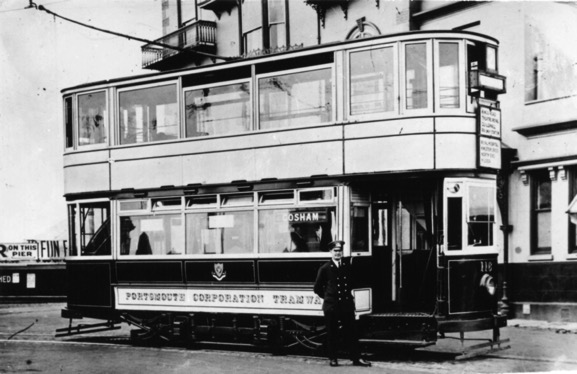
A motorman poses for the camera with Tramcar 116 at Clarence Pier — photo undated, but probably taken in the early 1920s given the pristine condition. Photo courtesy of the Tramways and Light Railway Society, with thanks to David Voice.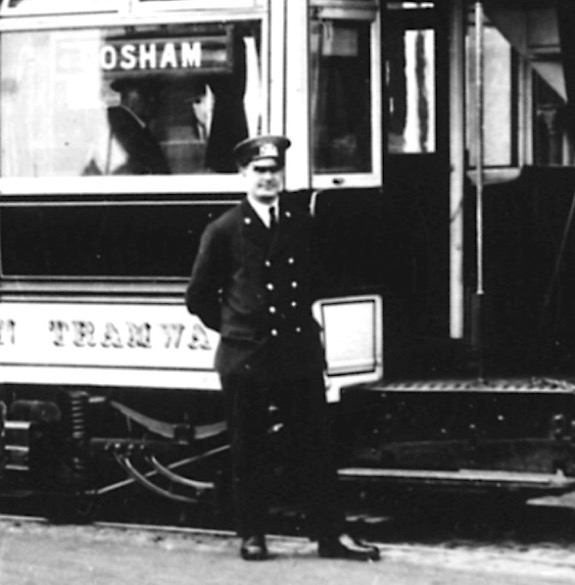
An enlargement of the above photograph showing the motorman; the large municipal cap badge (introduced in late 1916) and the lighter cut of the jacket compared to the earlier version, are apparent. 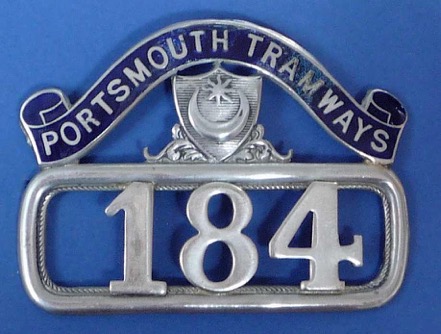
Portsmouth Corporation Tramways cap badge — nickel and blue enamel — introduced in September 1916. The relatively high number of this badge would suggest that it was issued to a motorman. Author's Collection.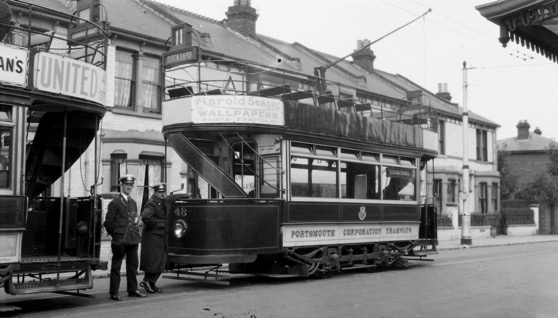
A conductor and a motorman pose for the photographer (Dr H Nicol) with two tramcars, one of which (No 48) is on a Route 11 service to the dockyard — photo undated, but probably taken in the early 1930s. With thanks to the National Tramway Museum. 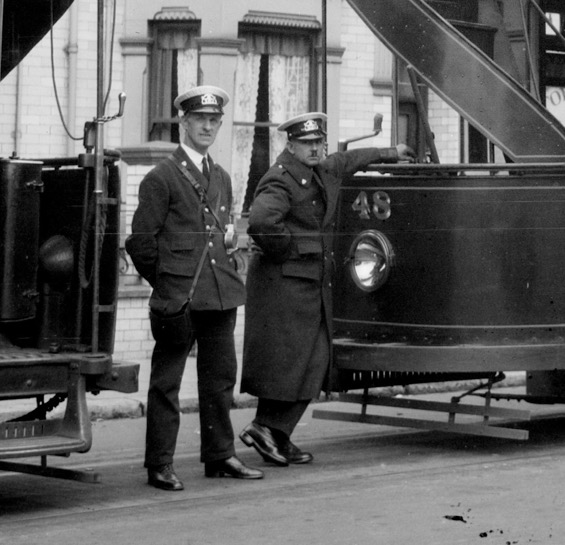
An enlargement of the above photograph showing the conductor and the motorman; the former is wearing a double-breasted jacket, but now with municipal-device badges on the collars rather than the system initials formerly worn there.
A rather battered-looking Tramcar No 65 and crew – photo undated, but probably taken in the early 1930s, this car being withdrawn in 1935. Photo courtesy of the National Tramway Museum.
An enlargement of the above photograph showing the conductor and the motorman, both in double-breasted jackets.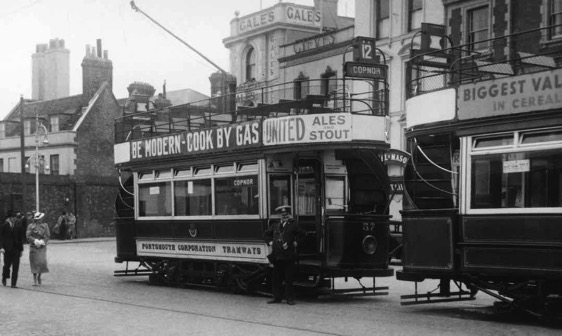
A conductor stands somewhat proprietorially with Tramcar No 57 at The Hard — photo undated, but very probably taken in the early 1930s. Photographer, A D Packer. With thanks to the National Tramway Museum. 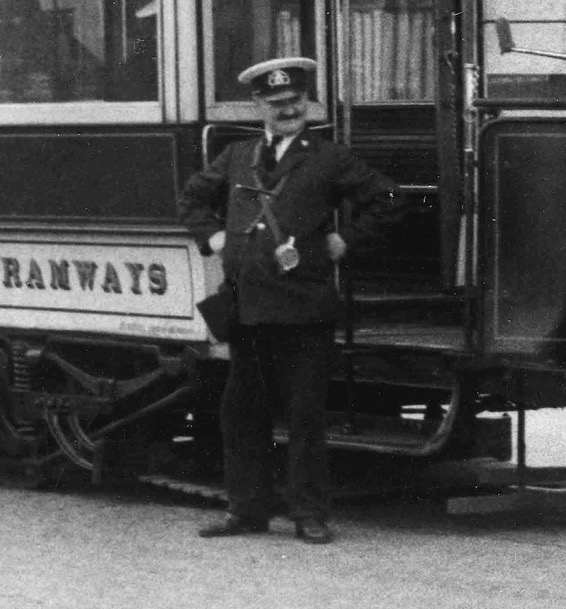
An enlargement of the above photograph showing the conductor; it is the only image I'm aware of which appears to show a tramway employee wearing a single-breasted jacket.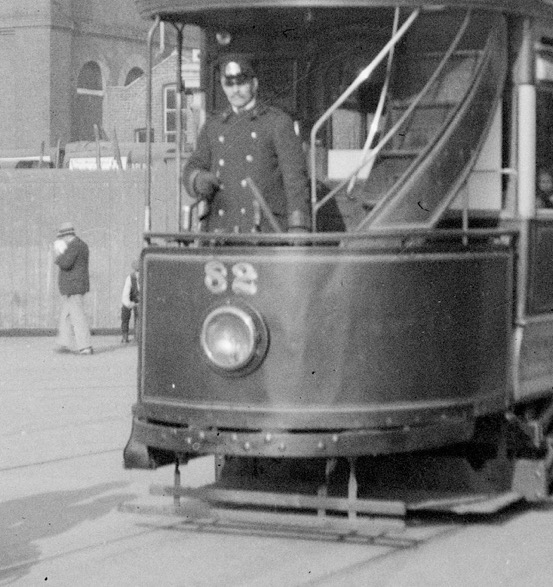
A motorman at the controls of Tramcar No 82 — photo undated, but probably taken in the early 1930s. Photographer, M J O'Connor. With thanks to the National Tramway Museum. 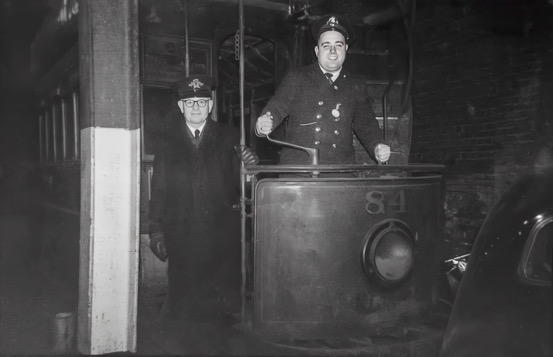
Tramcar No 84 captured in what would appear to be a depot yard — although the photo is undated, it was probably taken towards the end of tramway operation (i.e., circa 1936) and may have been taken to commemorate the closure of a line or even the entire system. The man in the overcoat (left) is certainly a senior uniformed member of staff, probably an Inspector.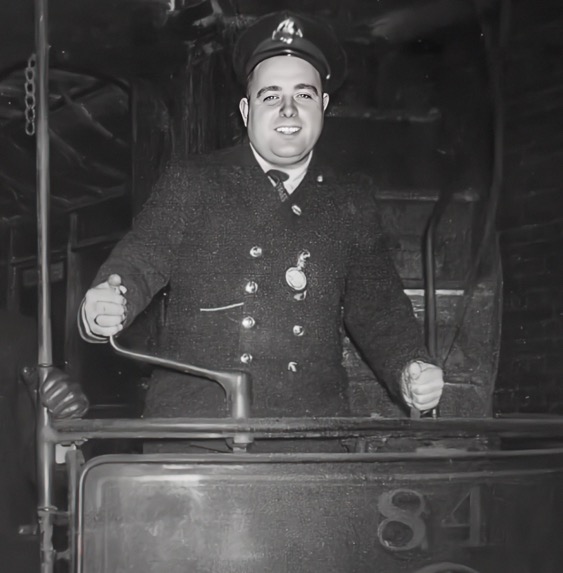
An enlargement of the above photograph showing the motorman. A PSV drivers' licence badge is suspended from one of his jacket buttons; these were not required for tram driving, so he may well also have driven motorbuses and or trolleybuses, for which it was a legal requirement.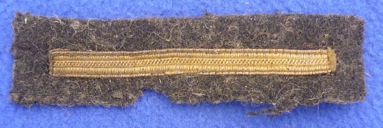
Unknown stripe badge, probably worn on the jacket sleeve, possibly denoting long service or good conduct — bullion-embroidered cloth. Author's Collection.
City of Portsmouth Passenger Transport Department cap badge (introduced some time after July 1936), though possibly not before the demise of the tramway — nickel and blue enamel. Author's Collection.
Senior staff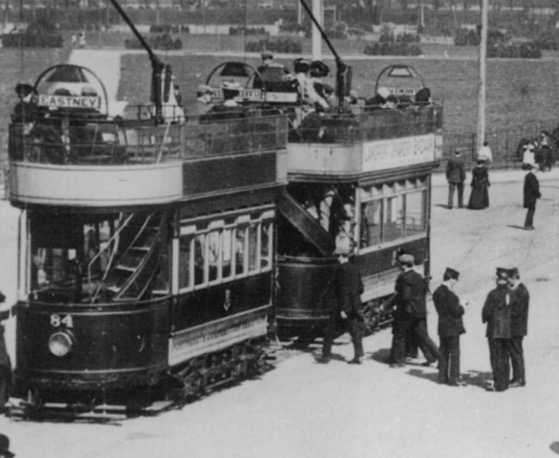
Tramcar No 84 with a service for Eastney stands in front of the Victoria Barracks — photo undated, but probably taken in the mid-to-late Edwardian era. The three figures on the right are probably inspectors, all of whom appear to be wearing kepi or drooping-peak caps. Photo courtesy of the Tramways and Light Railway Society, with thanks to David Voice.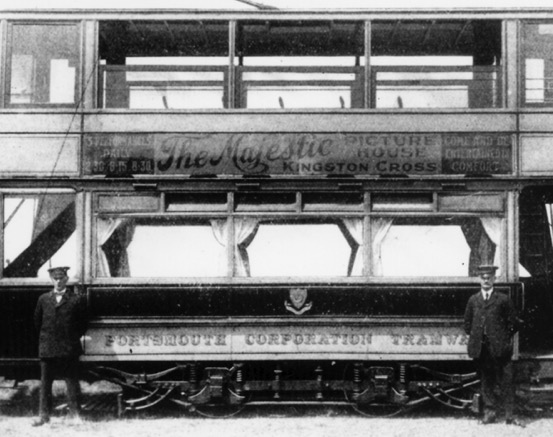
Two individuals pose with an unidentified tram — photo undated, but almost certainly taken prior to the Great War. In contrast to the double-breasted jackets worn by tramcar crews, the two men depicted here are wearing single-breasted jackets, which suggests that they may be a more senior grade. Photo courtesy of the Tramways and Light Railway Society, with thanks to David Voice.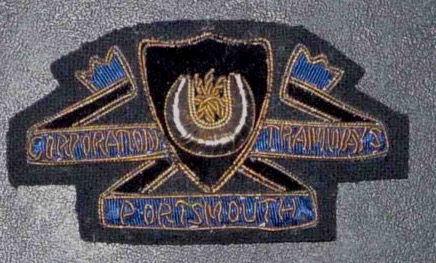
PCT cap badge — bullion-embroidered cloth. It is unclear which grades this cap badge was used for, though it was possibly for inspectors (during the tramway era). Author's Collection.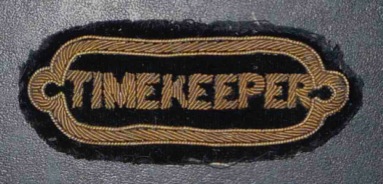
Timekeeper's collar badge — bullion-embroidered cloth. Author's Collection.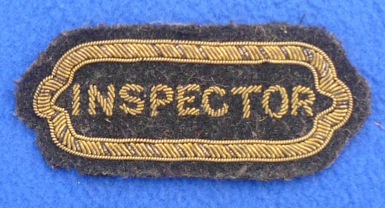
Inspector's collar badge — bullion-embroidered cloth. Author's Collection.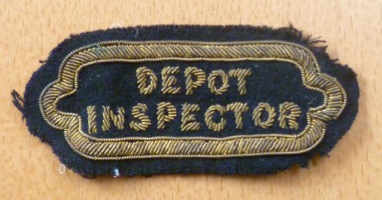
Depot Inspector's collar badge — bullion-embroidered cloth. Author's Collection.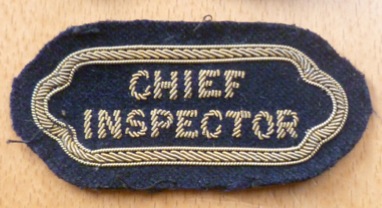
Chief Inspector's collar badge — bullion-embroidered cloth. Author's Collection.
An enlargement of the depot photograph above showing details of the senior staff member, possibly an inspector of a chief inpsector. The subject would appear to be wearing a City of Portsmouth Passenger Transport inspector's cap badge (shown below), the departmental name having only changed to this form barely four months before the last tram ran.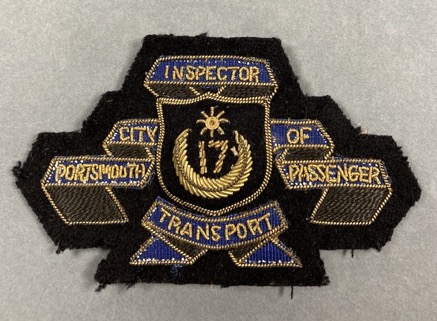
A City of Portsmouth Passenger Transport inspector's cap badge, No 17 — bullion-embroidered cloth.
Female staff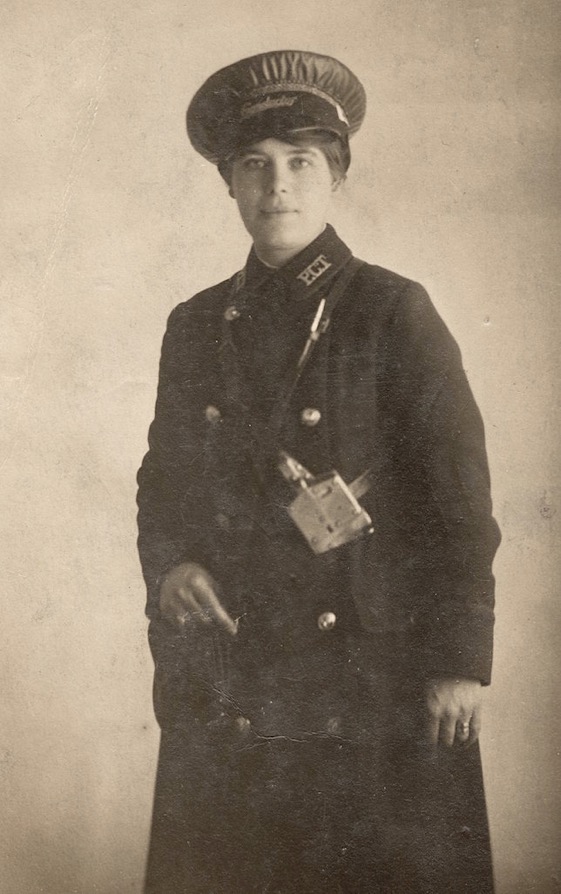
A studio portrait of a conductress, probably called Maude, by a Portsmouth-based photographer — photo undated, but likely to have been taken early in the Great War as she is not wearing the new style of cap badge issued in September 1916. Author's Collection.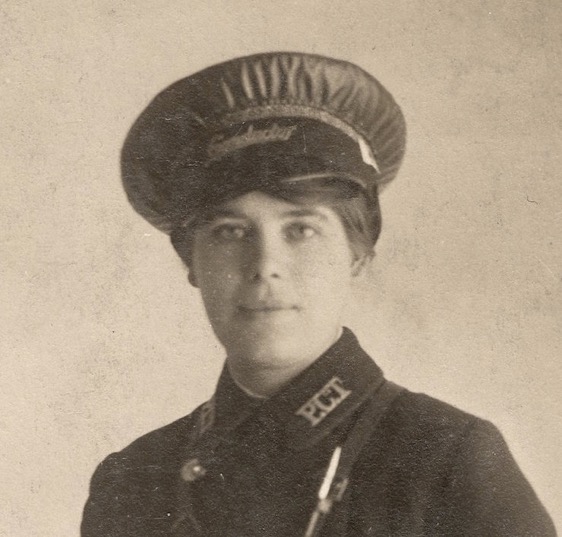
An enlargement of the above photograph showing the newer 'P.C.T' one-piece collar badges, though she still has the older script-lettering grade badge on her cap. The cap probably has a woven straw crown, though this is hidden by a rain cover.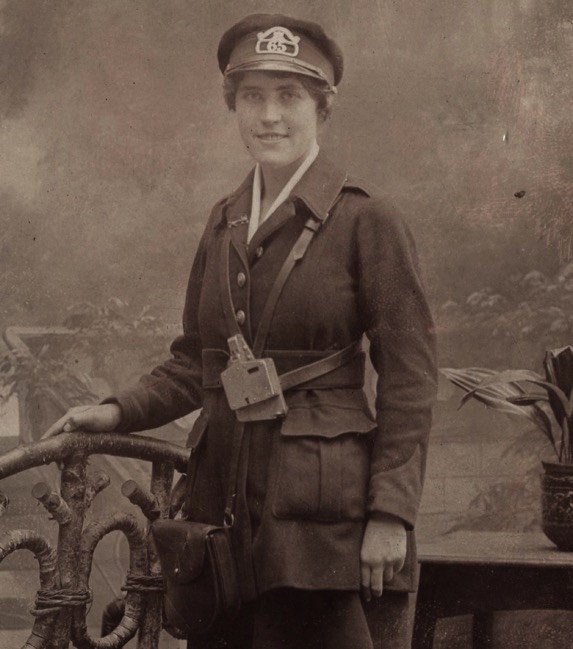
A PCT tram conductress (Employee No 65) — 1916. On the back of the photograph, the inscription reads: "Auntie Florrie Rutland 1916, on the trams at Portsmouth". Although she is wearing the new corporation cap badge (introduced in September 1916), her tunic collars are missing the usual PCT initials badges; she also sports a baggy peaked cap, sometimes referred to as a motor cap. Florence Maud Rutland was born in Weymouth in 1896. In 1911 she was still in Weymouth and was working as a housemaid, and in 1921, she had returned to house duties (in the house of her parents) in Copnor. Author's Collection.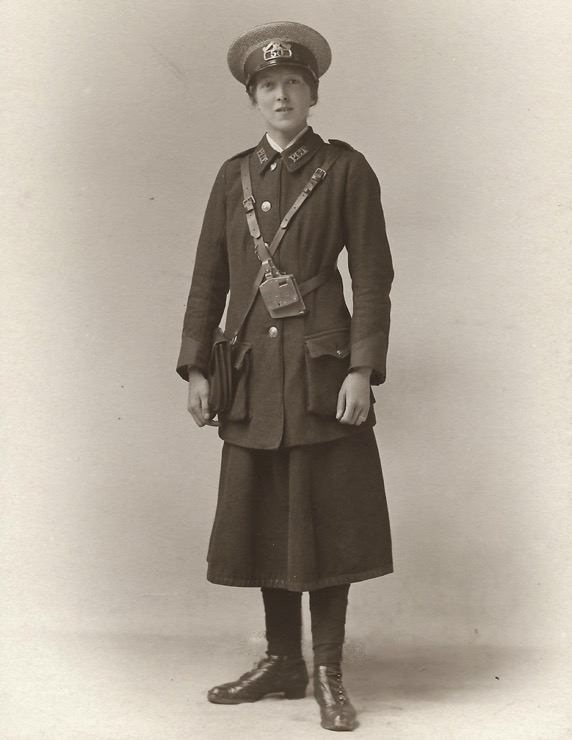
Great War Portsmouth tram conductress Alice Emberton (nee Knight James) — photo undated, but certainly taken after September 1916 and no later than 1919. Photo with kind permission of Anne Stocks, Alice's granddaughter.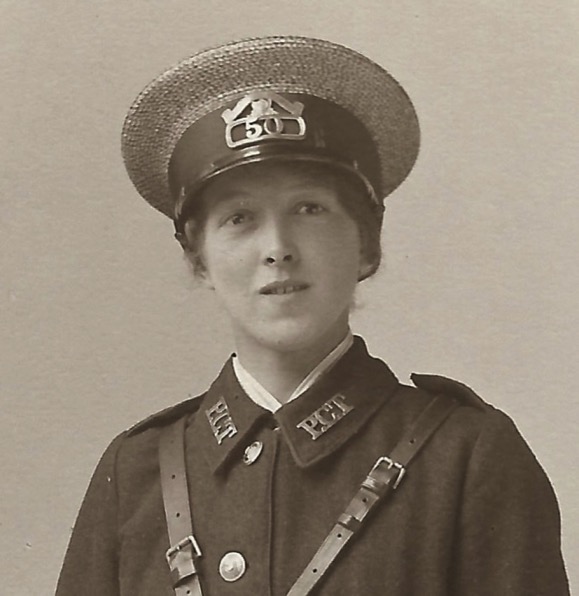
An enlargement of the above photograph showing details of the collar insignia, as well as the employee number (No 50). The subject is wearing a tensioned-crown peaked cap with a wide straw crown; these would have been issued for summer use.